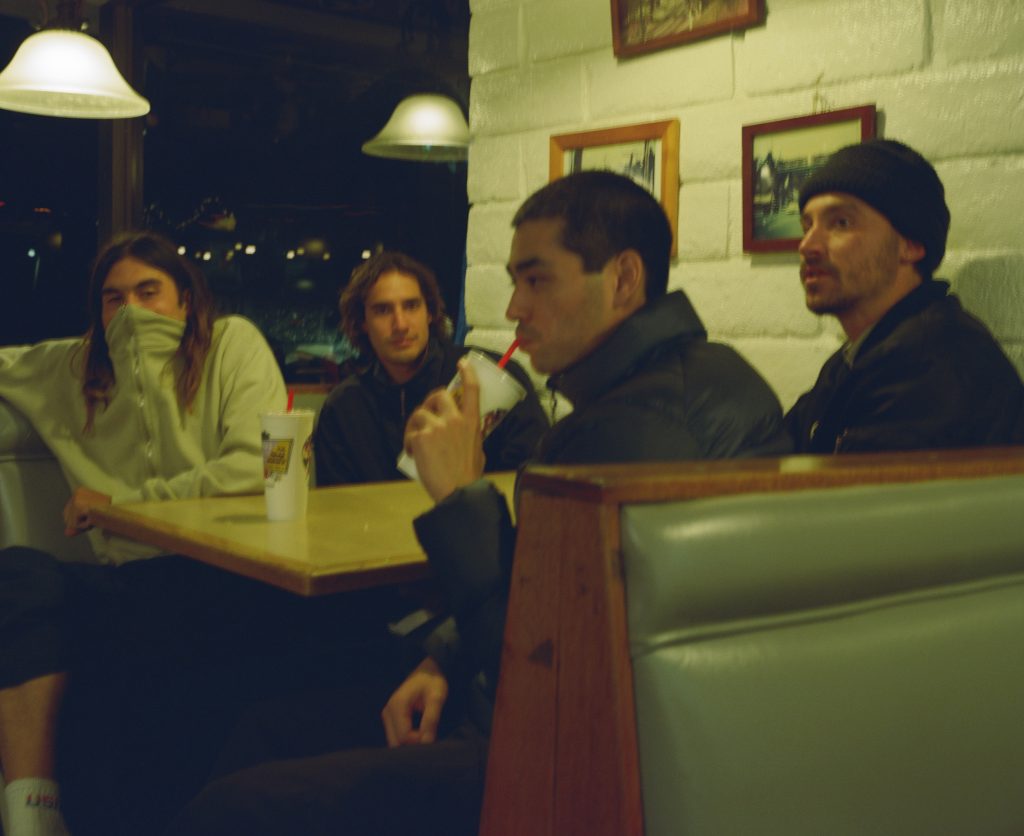Lo slowcore immaginifico dei Bondo: intervista alla band

Bondo al Rick’s Drive In & Out, vicino al Dodger Stadium di Los Angeles
La musica spesso parla per immagini. I losangelini Bondo, prima con l’EP di debutto autoprodotto 77 (uscito nel 2021) e poi con l’album Print Selections (pubblicato il 24 febbraio dalla fiorentina Quindi Records), sono riusciti con il loro slowcore immaginifico a disegnare scenari sonori granulosi, sabbiosi: le emozioni, i ricordi e i pensieri diventano dei flashback impressionisti girati in slow motion. Un suono, quello del quartetto, ondivago, fluttuante che nel minimalismo trova il suo climax emotivo: andare oltre il rock per abbracciare una musica d’atmosfera, espressione delle idee sonore che girano nella testa dei quattro componenti della band.
Abbiamo parlato con i Bondo della loro poetica sonora, dell’approccio del gruppo alla composizione e di tanti altri aspetti che ci hanno incuriosito:
Parlando del nome della band, la parola Bondo ha molti significati ma può essere usata per indicare le persone che vivono nelle regioni collinari del distretto di Malkangiri, nel sud-ovest dell’Odisha, in India. Vi sentite un’unità artistica isolata dal resto? Che cosa significa per voi la parola Bondo?
Il Bondo negli Stati Uniti è un prodotto per la reparazione di buchi in automobili, pareti, metallo, legno, ecc. È un composto chimico che si indurisce in 15 minuti e può essere levigato. È abbastanza maleodorante e appiccicoso, ma molto utile per i suoi tanti impieghi.
La natura versatile del bondo è stata la ragion per cui, in parte, abbiamo pensato che come nome fosse adatto alla nostra musica. È una pasta “adesiva”, quindi assume la forma che desideri e una volta indurito, mantiene quella forma in maniera permanente.
La scelta di due brani come Egoizing e New Brain come singoli non mi sembra casuale. A mio avviso, rappresentano l’anima creativa del disco: la volontà di non far prevalere l’io individuale e la mente del singolo membro all’interno di una cerchia di persone (come avviene nel video di Egoizing).
Sì, certamente. Il contenuto lirico disseminato nei due brani è tutto collegato dal tema della dissoluzione del sé individuale. Come band siamo concentrati sull’espressione collettiva: c’è un’allegra alchimia che avviene all’interno delle dinamiche da gruppo, e facciamo del nostro meglio per permettere a tutte le nostre diverse opinioni individuali di giungere, naturalmente, a un compromesso su qualcosa di nuovo. “Il tutto è maggiore della somma delle sue parti” o qualcosa del genere.
Le copertine in bianco e nero del vostro EP e dell’album sono una scelta narrativa interessante. È voluta?
Esteticamente abbiamo sempre pensato che la musica assomigliasse molto a una stampante xerox, o alle scansioni granulose che si ottengono in biblioteca utilizzando le macchine più vecchie. Penso che queste foto in bianco e nero lascino anche spazio alla musica affinché sia quest’ultima a parlare per se stessa: quando facciamo questa musica, siamo completamente concentrati sul modo in cui suona in quel momento e non su come si presenterà.
Per quanto riguarda la copertina di “Print Selections”, mi sono divertita a usare Google Immagini per rintracciare la fonte dell’immagine. Non ci sono riuscita, ma i risultati mi hanno fatto riflettere. Tra le immagini corrispondenti compaiono: “Antenne aliene negli abissi”, “Ufiti, il fantasma della baia di Nkata”, “Scintillio del sole”, e fotografie del mare di Mario Giacomelli. Da un dettaglio misterioso, le prospettive possono essere molteplici. Si possono vedere molte cose in quel pezzo di foto. Credo che questo sia un fatto interessante, no?
L’intenzione dietro l’immagine di copertina è che sia molto astratta e abbia una sorta di sensazione di test di Rorschach. Le persone tendono a vedere cose diverse ma l’immagine evoca qualcosa di sottile a livello emotivo. Qualcosa di simile alla musica.
Molte delle immagini di riferimento per l’album erano scansioni in bianco e nero di libri sugli UFO, foto di film con molte perdite di luce, ecc.. Tutte evocano sensazioni simili a quelle che abbiamo provato con la musica.
L’immagine in realtà raffigura la luce che si riflette sull’acqua.
Abbiamo trovato che fosse molto adatta – alcune cose molto semplici interagiscono in un modo unico che è momentaneamente accattivante.
Siete stati paragonati agli Acetone, e probabilmente sono tra i gruppi a cui vi siete ispirati, ma ciò che mi ha colpito nella musica di Bondo, fin dall’ascolto del primo EP, è lo sviluppo ondulatorio dei brani, come se la musica fosse un’onda da surfare. C’è molta enfasi sulla creazione di un’atmosfera sonora. Il brano che meglio rappresenta questa idea è “Pipecleaner”. Credo che sia un tratto distintivo della vostra musica. Cosa ne pensate?
Ho molto rispetto degli Acetone. Per me esemplificano l’ideale di una vera band. Il loro pezzo Germs è forse il brano più riuscito che sia mai stato scritto ed eseguito. Evoca una sensazione così potente, una cosa così unica e bella che solo quei tre membri della band potevano realizzare.
L’atmosfera sonora è molto importante per noi. La nostra musica (e forse tutta la musica, si può dire) ha a che fare con la creazione di un’atmosfera, con i sentimenti più di ogni altra cosa. Il sentimento è una cosa così sottile e per animare i diversi aspetti del sentimento bisogna essere sia intenzionali che flessibili. Questo è tutto ciò che cerchiamo di fare quando facciamo musica, avvicinarci a quelle sensazioni e a quei suoni che immaginiamo nella nostra testa.
Ci sono brani come “Container” e “Lo Tek” che, per la loro breve durata, sembrano dei quadri impressionisti: pennellate sonore in libertà. Mi sbaglio?
Credo che tu abbia ragione. Piccoli stati d’animo, piccole cose che passano e che danno la sensazione di movimento senza stimolare eccessivamente.
Trovo che il titolo dell’album “Print Selections” sia appropriato: vedo le canzoni come immagini sonore stampate sul disco in vinile. Non so se la mia interpretazione sia corretta.
Ben detto, direi che sono d’accordo. Il nome deriva dal mixaggio: il nostro ingegnere Andrew Oswald ci ha inviato i file finali mixati, alcuni dei quali sono stati mandati su nastro un paio di volte e poi resi di nuovo digitali. Una cartella era intitolata Print Selections. Sembrava adattarsi bene alle canzoni.
A seguire la versione originale, in inglese, dell’intervista [ENG]
Speaking about the band’s name, the word Bondo has many meanings but can be used to indicate the people living in the hill regions of the Malkangiri district of southwestern Odisha, India. Do you feel like an artistic unit isolated from the rest? What does the word Bondo mean to you?
Bondo in the US is a product for filling holes on cars, walls, metal, wood, etc. It’s a chemical composite that hardens in 15 minutes so it can be sanded. It’s fairly smelly and sticky, but very useful for many applications.
Its versatility was part of the reason why we felt the name fit our music. It is a “bonding” putty, so it takes whatever form you want it to and once it is cured, it takes on that form permanently.
The choice of two tracks like “Egoizing” and “New Brain” as singles does not seem to me to be a random choice. In my opinion, they represent the creative soul of the record: the desire not to let the individual ‘I’ and the mind of the single member prevail within a circle of people (as you are in the video of “Egoizing”).
Yes, definitely. The sparse lyrical content is all connected by the theme of dissolving the individual self. As a band, we are focused on collective expression. There is a fun alchemy that happens with group dynamics, and we do our best to allow all of our differing individual opinions to naturally compromise on something new. “The whole is greater than the sum of its parts” or something like that
The black and white photo covers of your EP and album are an interesting narrative choice. Is it intentional?
Aesthetically we’ve always felt the music feels a lot like a xerox printer, or the grainy scans you get at the library on older machines. I think these black and white photos also leave room for the music to speak for itself – when making this music, we are entirely focused on the way it sounds at that moment and not how it will present itself.
Regarding the cover of ‘Print Selections’, I had fun using Google Images to trace the source of the image. I have not succeeded, but the results have made me think. Among the corresponding images appear: “Alien Antennae in the Abyss”, “Ufiti, the Ghost of Nkata Bay”, “Sparkle of the sun”, and photographs of the sea by Mario Giacomelli. From one mysterious detail, perspectives can be multiple. You can see many things in that piece of photo. I think this is an interesting fact, no?
The intention behind the cover image is that it is very abstract, and has a sort of Rorschach test feeling to it. People tend to see different things, but the image does evoke something subtle on the feeling level. Something similar to the music.
Many of the reference images for the record were black-and-white scans of books on UFOs, films photos with lots of light leaks, etc. All evoke feelings similar to what we felt from the music.
The image is actually some light reflecting off of the water. We found that to be very suitable: some simple things interact in a unique way that is momentarily captivating.
You have been compared to Acetone, and they are probably among the bands you were inspired by, but what struck me in Bondo’s music, from listening to the first EP, is the undulating development of the tracks, as if the music were waves to surf. There is a lot of emphasis on creating a sonic atmosphere. The track that best represents this idea is ‘Pipecleaner’. I think it is a hallmark of your music. What do you think of it?
I have a lot of respect for Acetone. They, to me, exemplify the ideal of a real band. Their song “Germs” is maybe the most successful song ever written and performed. It evokes such a powerful feeling, such a unique and beautiful thing that only those three band members could make.
The sonic atmosphere is very important to us. Our music (and it can maybe be argued, all music) is about mood making, dealing with feelings more than anything else. Feeling is such a subtle thing and to enliven different aspects of feeling one has to be both intentional and flexible. This is all we are trying to do when we make music, get close to those feelings and sounds we imagine in our heads.
There are tracks like ‘Container’ and ‘Lo Tek’ that, for their short duration, sound like impressionist paintings: sound brushstrokes in the wild. Am I wrong?
I think you’re right. Small moods, little passing things that give the feeling of movement without overstimulating.
I find the album title ‘Print Selections’ fitting: I see the songs as sound images printed on the vinyl record. I don’t know if my interpretation may be correct.
That’s well put, I’d say I agree. The name comes from mixing – our engineer Andrew Oswald sent us the final mixed files, some were sent to tape a few times then made digital again. One folder was titled Print Selections. It seemed to fit the songs well.
Un grazie speciale alla Quindi Records
(Monica Mazzoli)








